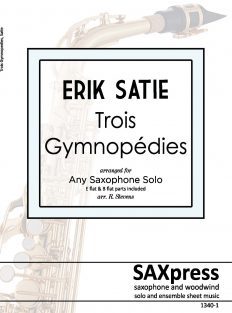Five Nocturnes (1919)
Erik Satie (1866 – 1925)
SATB Saxophone Quartet
Five Nocturnes by Erik Satie arranged for SATB saxophone quartet. Five Nocturnes (or “Cinq Nocturnes” in the original French) is a set of piano pieces written by Erik Satie. They are among the final works for piano he wrote. The set is considered one of his most significant achievements. Unlike much of Satie’s earlier piano music they are completely serious. There are no wacky titles, musical satire, or private notes to the performer – all trademarks of his earlier works. He chose to let the Nocturnes stand as “pure” music. Originally he planned to compose seven pieces for this set but only provided publishers with the five nocturnes we have here.
Using simple melodic ideas, Satie expands the nocturne into something beyond the romantic period piece using fresh harmonies and mixed meters. Originally written for solo piano, this arrangement of Five Nocturnes is for SATB Saxophone Quartet. Tom Zinninger’s arrangement of Five Nocturnes by Erik Satie had its premiere performance by the Texas A&M University-Kingsville Saxophone Quartet on November 6, 2019.
- The range for each saxophone part is shown below.
- Audio and score excerpts are available above.
- Registered users can download a complete sample score and full length audio file of Five Nocturnes on the ‘Samples’ tab above.

About the Composer
 Éric Alfred Leslie Satie: 17 May 1866 – 1 July 1925)
Éric Alfred Leslie Satie: 17 May 1866 – 1 July 1925)
Born May 17, 1866 in Honfleur, Basse-Normandie, France, Satie was a composer, and a performing pianist, though mainly for café- and cabaret audiences. Satie wrote theatre and ballet music, as well as piano music. His compositions are original, humorous, often bizarre, and very minimalistic. His music is sometimes called furniture music, supposed to be in the background of everyday life. It is evidently anti-romantic and also anti-impressionistic. Satie eventually became a leading figure of the French avant-garde. He was not taken seriously as a composer by his contemporaries until he was in his forties.
In 1917 the first performance in Paris of the ballet Parade (the orchestration of which included parts for typewriter, foghorn and rattle) caused a scandal, which established his name as a composer. Satie wrote this ballet together with Jean Cocteau and Pablo Picasso for the Russian impresario Diaghilev, leader of the Ballets Russes. Satie gave his piano pieces names like Unpleasant Glimpses, Genuine Flabby Preludes (for a dog), or Old Sequins and Old Breastplates. He accompanied the scores of these pieces with all kinds of written remarks, insisting that these should not be read out during performance.
Every day of his working life Satie left his apartment in the Parisian suburb of Arcueil to walk across the whole of Paris to either Montmartre or Montparnasse before walking back again in the evening. Satie was known as an eccentric, and amongst other things he started his own church (with himself as only member). Debussy and Ravel were among his friends. He was not hailed by the masses but was admired by many young composers and musicians. In fact, Satie was the center of the Groupe des Six, a group of six French composers (Auric, Durey, Honegger, Germaine Tailleferre, Milhaud and Poulenc. The group advocated clear musical language, and opposed impressionism (for example Debussy and Ravel), slavism (Stravinsky) and post-Wagnerism (Schönberg) in music.
Erik Satie died on July 1, 1925 and is buried in Cimetiere d’Arcueil, Arcueil, France.
About the Arranger
 Tom Zinninger
Tom Zinninger
Originally from Louisville KY, Dr. Thomas Zinninger has worked as an active saxophonist, composer, arranger, and music educator for the past 20 years. Equally comfortable in a number of styles, his musical experience ranges from combo and big band jazz to classical chamber and orchestral music.
Zinninger ‘s performance credits include the Cincinnati Pops Orchestra, the Cincinnati Chamber Orchestra, the Richmond Symphony Orchestra, the Kingsville Symphony Orchestra, the Frank Simon Band, the Chamber Winds of Louisville, the Blue Wisp Big Band, and the Cincinnati Contemporary Jazz Orchestra. As a soloist, he has premiered new arrangements for the saxophone at the 16th World Saxophone Congress in St. Andrews Scotland, as well as the 2012, 2014, and 2017 North American Saxophone Alliance Conferences.
Zinninger is currently the Assistant Professor of Saxophone and Jazz at Texas A & M University Kingsville. His duties include teaching applied saxophone, directing the jazz combo and saxophone chamber ensemble programs, teaching saxophone methods, and teaching courses in jazz improvisation. Prior to joining the TAMUK faculty in 2018, he held the Instructor of Saxophone position at Wittenberg University in Springfield, OH where he also directed the jazz ensemble and taught music appreciation. Zinninger has also served both as a graduate assistant and on the faculty at the College-Conservatory of Music (CCM) in Cincinnati, OH. He received a Bachelors in Music Education from the University of Louisville, and a Masters of Music in Jazz Studies and Doctorate of Musical Arts in Saxophone Performance from CCM.










Reviews
There are no reviews yet.